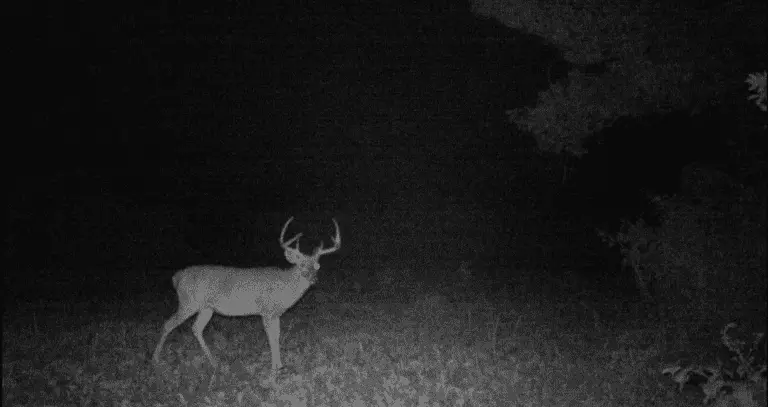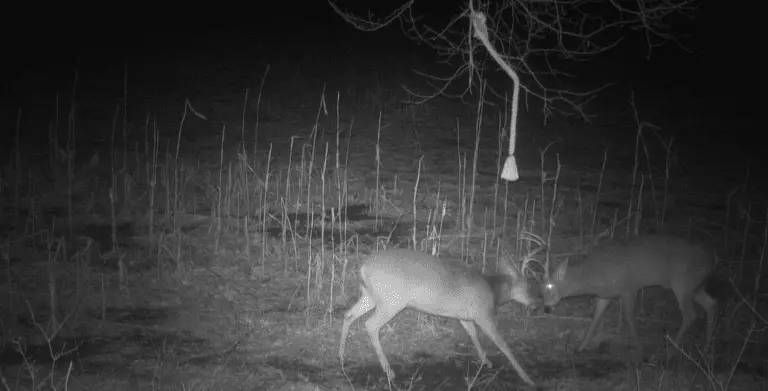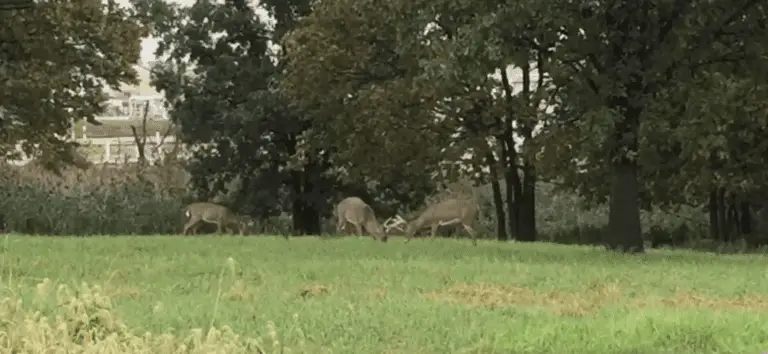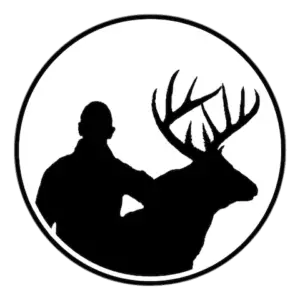Male deer, also known as bucks, can put on a show when they fight each other. It’s truly amazing to see two bucks aggressively going at it. I have witnessed several buck fights in person while hunting. Additionally, I monitor deer with trail cameras and have captured many videos of bucks fighting over many years. If you witnessed a fight before, it might make you wonder why male deer fight each other. Well, here’s why…
Bucks fight each other for dominance and to earn the right to breed does within their home range. Most fights happen around the timing of the rut (October – December). Prior to peak breeding times, dominance is sorted out among bucks that live within the same home range. Bucks will also travel outside their home ranges to look for does to breed. This results in bucks encountering each other that need to sort out who the dominant buck is. If a female deer is receptive and ready to breed, it’s common for two bucks to fight each other in hopes to running the other off so they can breed that doe.
It’s important to mention that bucks playfully “fight”. Bucks commonly play with each other by rattling their antlers together. This behavior might appear like they are fighting, however there is no aggression behind it. Playful “fighting” typically happens between bucks outside the peak breeding season, and one of the bucks is usually young and not fully mature. Something you won’t see very often is two mature bucks playfully “fighting”. When two mature bucks fight, it usually has aggression and meaning behind it.
Here is a list of ten common questions that people commonly ask regarding buck fights that I have answered based on years of observations:
1. How long do buck fights last?
Buck fights can be over in a few seconds or can last up to an hour or two. Most fights are over within one to five minutes. If a fight last longer than a couple of hours, then it’s probably because those two bucks got their antlers stuck together, are locked up, and having a difficult time separating from each other.
2. Do deer get hurt when they fight?
Deer get hurt all the time when they fight, however they don’t always get injured. Common injuries that happen are punctures to the skin from antlers or poking an eye out and causing blindness. It’s easy to see if a deer has a blind eye when he gets his photo or video taken at night because there won’t be a reflection on the eyeball. Notice in the picture below how one eye is glowing and the other isn’t.
Deer also get injured in other ways to all parts of their body. Leg and foot injuries are somewhat common among deer, and those injuries can happen from fights or from traversing through tough terrain.

3. Do bucks fight to the death?
Bucks don’t fight to the death intentionally. However, death does occur from fighting. Sometimes the injuries caused from fights will kill deer the same day the fight occurred. Other times, injuries will fester and result in wounds getting infected that end up killing deer. Bucks can also get their antlers stuck together while fighting making it nearly impossible for them to break apart from each other. This ends up in both bucks dying most of the time. However, on very rare occasions, one of the bucks might be able to twist its body around the dead buck enough and can tear its head away from its body.
4. Do big bucks always win fights?
How do you define what a big buck is? There are bucks with big bodies and there are bucks with big racks. A buck with a large rack doesn’t always have a big body, and vice versa. All deer have different personalities, and aggression levels can be vastly different from each other. Deer are kind of like humans in this way. If an average joe is fighting another average joe, then the guy who has the bigger body will most likely win the fight if he can match the aggression levels of the other guy. The same thing goes for deer. Bucks with large antlers lose fights all the time. Some large bucks don’t like to fight at all and will just run away from conflict just like some humans would run away from a fight. In conclusion, big bucks don’t always win fights.
5. Do Bucks fight at night?
Yes, bucks fight at night. Deer move at all times of the day and night and will fight each other regardless of what time it is. If human pressure is high in an area, it’s more likely that bucks will fight during the night than they will during the daytime in that specific area.
6. Do Bucks fight during the rut?
Yes, bucks do the majority of their fighting during and around the rut (October – December). Once bucks have shed the velvet off their antlers, they will start rubbing them against tree trunks to build up their neck muscles for fighting. The aggressive fighting begins to take place when most bucks have lost their velvet (October). Buck’s fight during the rut to sort out the dominance between themselves to see who is going to be breeding the does in that area.

7. Do bucks fight all year long?
Yes, bucks do fight all year long. However, the way they fight and the frequency of fights happening will be different based on the time of year. Bucks shed their antlers every year. Growing a new set of antlers takes several months. When bucks don’t have antlers, they will stand up on their back legs and fight each other with their front feet. They will also fight this way when their antlers are still in the growing phase with velvet on them. There’s a low amount of fighting outside of the rut. However, bucks will continue to test their dominance all year long while they are in bachelor groups to establish a pecking order between them. Click the link to learn more about when bachelor groups break up.
8. Do Bucks fight for does?
Yes, the primary reason why bucks fight is to earn the right to breed does. Bucks establish a pecking order within the herd all year long. When the time comes to breed does, the fighting will become more intense and will happen more frequently than at other times of the year. The majority of does come into estrus and are ready to breed within a short window of time. Dominate bucks usually don’t have enough time to breed every doe in the area within that short window. Less dominate bucks, or bucks traveling outside their typical home ranges, will enter the picture and try to breed those does. When a mature buck is moving from doe to doe, sometimes he will discover another buck trying to breed a receptive doe. If this happens, he will most likely try to fight the other buck off that doe so he can be the one to breed her.
9. Do bucks fight for food?
No, bucks don’t really fight over food. However, individual bucks can get territorial and will try to intimidate approaching bucks to get away from them while feeding. You typically only see this kind of behavior when the food is in a small spot, like at a feeder. If deer can spread out and not feed next to each other then they won’t fight over food. During the hunting season you might witness a buck running another buck off or fight him near a food source. These bucks are fighting over does, not food.

10. How to tell if bucks are about to fight?
The most common signs of deer aggression can be recognized while looking at their body language. Signs of deer aggression are not always verbal, but I will cover those in the next paragraph. Most of the time you can tell when bucks are aggressive and ready to fight just by reading their body language. A fight is likely to happen if two bucks are approaching each other with their tails tucked under their butt and ears laid down and pointed backward. Bucks about to fight will walk slowly to each other, and once they get about five yards apart, they will lower their heads and explode towards each other to start fighting.
Bucks can also show aggression before they decide to approach another buck to fight. For example, they might snort wheeze to tell another buck he doesn’t like him in his area. Bucks will also rub trees and make scrapes aggressively. When making scrapes, bucks will thrash a branch hanging over the scrape and then paw at the ground aggressively. This can create a lot of noise. You might also see a buck charge towards another buck that he already established dominance with. This kind of behavior is how a buck will tell another buck to leave his area, or else he is going to fight him.
Conclusion
I hope this article provided you with a better understanding of why bucks fight, when they fight, and why they fight. Seeing an aggressive buck fight in person is an amazing experience to have. If you ever find two bucks fighting that are locked up together be very careful if you decide to approach them. People have been able to successfully get bucks separated that were locked up together, but the risk involved in doing that is high. You could get yourself injured or worse by getting involved. For assistance to split the bucks apart, call the game warden in your area.

